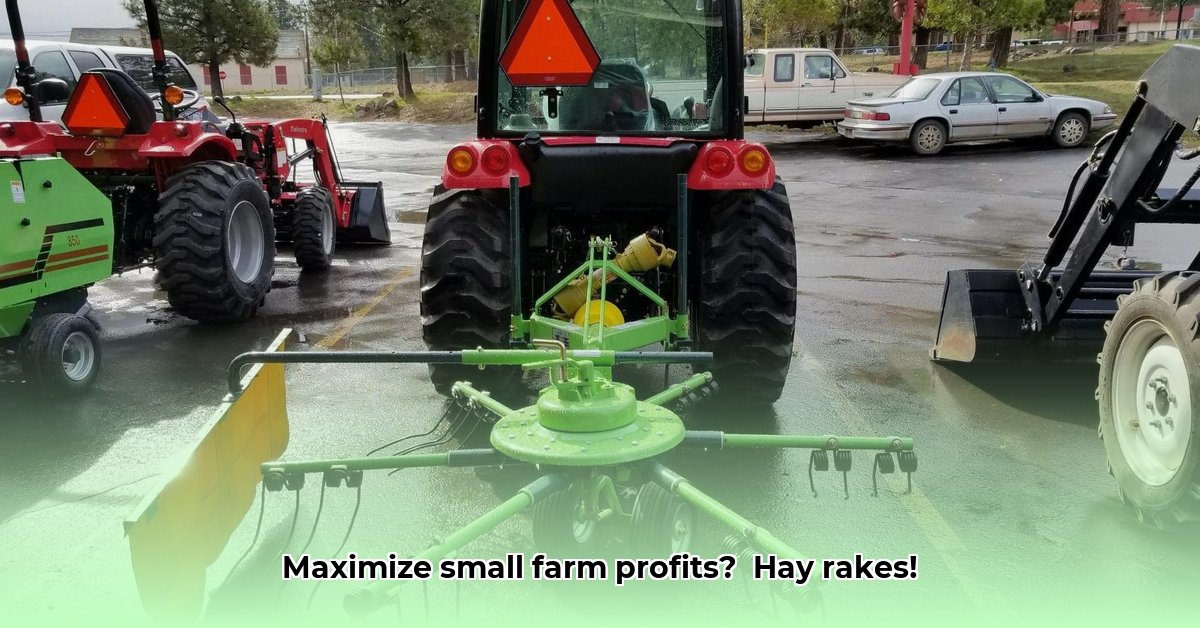
Choosing the right compact tractor hay rake can significantly boost your small farm's efficiency and profitability. This comprehensive guide explores the various types of rakes, helps you select the best model for your needs, and provides crucial operational and maintenance advice for sustainable hay production. For more information on compact tractors, check out this helpful resource: tractor loaders.
Understanding Your Options: Types of Compact Tractor Hay Rakes
Two primary types of compact tractor hay rakes cater to different needs: wheel rakes and rotary rakes. Each offers advantages and disadvantages, impacting your farm's efficiency and profitability.
Wheel Rakes: These simpler, less expensive rakes are easier to maintain, making them ideal for smaller farms with limited acreage. Their gentle action minimizes hay damage, preserving leaf and stem integrity and improving hay quality. However, their lower capacity necessitates more time for larger fields.
Rotary Rakes: Higher capacity rotary rakes are faster, perfect for larger farms prioritizing speed and efficiency. They are excellent for various terrains, but their higher price tag and more complex maintenance requirements require careful consideration. Their more aggressive approach could lead to higher leaf loss.
| Feature | Wheel Rake | Rotary Rake |
|---|---|---|
| Cost | Lower | Higher |
| Maintenance | Easier | More complex |
| Capacity | Lower | Higher |
| Hay Handling | Gentle | More aggressive |
| Terrain | Adaptable to most terrains | Less adaptable to uneven terrain |
Choosing the Right Rake: A Step-by-Step Checklist
Selecting the perfect rake requires a careful assessment of your farm's unique characteristics. Follow these steps to make an informed decision that maximizes efficiency and profitability.
Assess Your Farm's Needs: How many acres require raking? What's your annual hay yield? Larger operations might benefit from a rotary rake's higher capacity, while smaller farms may find a wheel rake more suitable.
Determine Your Budget: Establish a realistic budget encompassing not only the initial purchase price but also anticipated maintenance, repairs, and potential financing costs. Pre-approval for financing can streamline the process.
Ensure Tractor Compatibility: Your tractor must possess adequate horsepower to operate the rake efficiently and safely. Consulting your tractor's owner's manual will prevent damage from mismatched equipment.
Analyze Your Terrain: Evaluate your fields' topography. Wheel rakes handle varying terrains more effectively than rotary rakes, which can struggle on slopes or uneven surfaces.
Consider Your Hay Type: The type of hay you cultivate influences your rake selection. Some rakes handle delicate hay better than others; choose a model that minimizes leaf and stem loss.
Mastering the Machine: Operation and Maintenance for Optimal Performance
Efficient and safe operation, along with regular maintenance, is critical to maximizing your hay rake’s lifespan and ensuring consistent, quality results.
Pre-Operation Checklist:
Thorough Inspection: Before each use, inspect the rake for any damage or loose parts. This preventative measure avoids costly breakdowns and potential accidents. A well-maintained rake is a reliable and safe one.
Essential Lubrication: Lubricate all moving parts according to the manufacturer's recommendations. This reduces friction, extends the rake’s lifespan, and improves performance.
Safe Operation Procedures:
PTO Engagement: Engage the Power Take-Off (PTO) only while the tractor is stationary. This crucial safety measure prevents dangerous accidents.
Situational Awareness: Maintain constant awareness of your surroundings. Watch for obstacles, uneven ground and other potential hazards.
Regular Maintenance Schedule:
Post-Operation Cleaning: After each use, clean the rake thoroughly to remove debris that can damage components or hinder operation.
Tine Inspection: Regularly inspect tines (the teeth that gather hay) for wear and tear. Replace any damaged or worn tines promptly to ensure efficient work.
Adherence to Manufacturer Guidelines: Consult your owner's manual for a recommended maintenance schedule, which often includes lubrication, inspections, and other vital procedures.
Troubleshooting: Familiarize yourself with common problems and their solutions, using your owner's manual as a valuable resource. Seek professional assistance for complex repairs beyond your expertise.
Sustainable Haymaking: Minimizing Environmental Impact
Sustainable practices are vital for both environmental responsibility and long-term profitability. Compact tractor hay rakes contribute to sustainable hay production through fuel efficiency and reduced waste.
Compact tractors are significantly more fuel-efficient than their larger counterparts, minimizing your carbon footprint and reducing fuel costs. Proper raking techniques and regular maintenance help reduce hay waste, preserving hay quality and limiting environmental impact. Gentle hay handling, achieved through appropriate rake selection and operation, minimizes leaf and stem damage and reduces waste.
Success Stories: Real-World Examples of Efficient Hay Production
Numerous small-scale farms have successfully implemented compact tractor hay raking systems, boosting both efficiency and profitability. These case studies demonstrate the practical benefits and inspire further adoption of the technology. Researching these success stories can lead to valuable insights and inspire new strategies.
By carefully considering these factors, you can confidently choose a compact tractor hay rake suited to your needs, boosting your farm's profitability and environmental sustainability. Using this guide will ensure your success in efficient and productive haymaking.